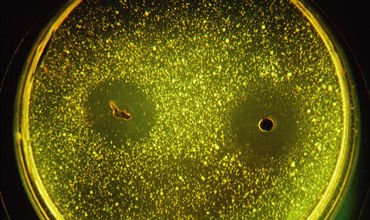Polychelates of Trivalent Selected Metal Ions of ‘4f’ Block With Phenolic Resin and Their Antimicrobial Activities

Abstract:
The
polymeric ligand (resin) was prepared from 2,4-dihydroxy benzophenone with 1,4-butane
diol in presence of polyphosphoric acid as a catalyst at 160° C for 13 hrs.. The poly [(2,4-dihydroxy benzophenone) 1,4-butylene
] i.e. H(DHBP-1,4-BD) forms, 1:2 metal: ligand chelates with La(III), Pr(III),
Nd(III), Sm(III),Gd(III), Tb(III), and Dy(III). The polymeric ligand and its
polychelates were characterized on the basis of elemental analyses, electronic
spectra, magnetic susceptibilities, thermogravimetric analysis, NMR and IR results.
The molecular weight was determined using number average molecular weight (
References:
[1.] Arimoto
F.S., HavenA.C., Derivatives of dicyclopentadienyliron, J. Am. Chem. Soc.,
77, 6295-6397, 1955.
[2.] Joshi J.D.,
Patel N.B., Patel S.D., Ion-exchange study of poly [(2,4-dihydroxy
benzophenone)propylene]resin and its polychelates: Synthesis, characterization.
J. Macro. Molecular Sci. Part A, PAC., 43, 1179-1188,
2006.
[3.] Mizuta T.,
Onishi M., Miyoshi K., Photolytic ringopening polymerization of phosphorus–birdge.
1: Ferrocenophane coordinating to an organometallic fragment, Organometallics,
19, 5005-5009, 2000.
[4.] Rivas B L.,
Maturana H.A., Molina M.J., Gomej- Anton M.R., Rosa M., Pierola I.F., Metal ion
binding properties of poly (N-vinylimidazole) hydrogels, J. Appl.
Polym. Sci., 67, 1109, 1998.
[5.] Tusa H.,
Paavola A., Harjula R., Letho J., 8th Int. Conf. of Radioactive Waste
Management and Environmental Remediation, 3, 42, 2001.
[6.] Orazzhanova
L.K., Yashkarova M.G., Bimendina L.A., Kudaibergenov S.E., Binary and ternary
polymerstrontium complexes and the capture of radioactive strontium-90 from the
polluted soil of the Semipalatinsk Nuclear Test site, J. Appl. Polym. Sci.,
87, 759-769, 2003.
[7.] Atia A.A.,
Donia A.M., Elwakeel K.Z., Selective separation of mercury (II) useing a
synthetic resin containing amine and mercaptan as chelating groups, Reacti.
Funct. Polymer, 65, 267-276, 2005.
[8.] Jacob A.M.,
Yizhak M., Ion-Exchange and Solvent Extraction, 13th Ed., Marcel &
Dekker Inc., New York, 1997.
[9.] Geckeler
K.E., Rongnong Z., Reaction products of amino or amide group containing polymer
with compounds containing functional and linking groups, Ger. Offen. DE ,
4227019, 1994; Chem. Abstr., 121, 10302f, 1994.
[10.] Alelah A.,
Moet A., Functionalised Polymers and Applications; Chapman and Hall,
London, 93, 1990.
[11.] Vankrevelen
D.W, New developments in the field of flame-resistance fibers, Angew.
Makromol. Chem., 22, 132, 1972.
[12.] Dentini
M., Santis P., Vardin A., Formation properties and structures of
bis(O-hydroxybenzylideneamine) copper(II) chelates of polypeptide ligands, Macromol.
Chem., 175, 327, 1974.
[13.] Patel
M.N., Patel J.B., Chelateing polymers of phenolic resin, J. Macromol. Sci. A
Chem., 19, 193-199, 1983.
[14.] Nho Y.C.,
Park J.S., Jin J.H., Antibacterial activity of sulfonated styrene-grafted
polypropylene fabric and its metallic salt, J. Macro. Molecular Sci. Part A,
PAC, 36, 731 -740, 1993.
[15.] Jayakumar
R., Rajkumar M., Nagendran R., Nanjundan S., Synthesis and characterization of
metal-containing polyurethanes with antimicrobial activity, J. Appl. Polym.
Sci., 85, 1194 - 1206, 2002.
[16.] Belfiore
L.A., Curdie M.P. M., Das P.K., Macromolecule-metal complexes: Ligand field
stabilization and thermophysical property modification. Polymer, 42,
9995 - 10006, 2001
[17.] Nursen S.,
Ebru K., Bekir S., Aulin O., Synthesis of some polymer-metal complexes and
elucidation of their structures, J. Macro. Molecular Sci. Part A, PAC,
43, 1227-1235, 2006.
[18.] Silverstein
R.M., Webster, F.X., Spectrometric Identification of Organic Compounds, 6th
Ed., John Wiley, New York, 1998.
[19.] Eliassi
A., Modarress H., Water activities in binary and ternary aqueous system of
poly(ethylene glycol), poly(propylene glycol) and dextran, Euro. Polym. J.,
37, 1487-1492, 2001.
[20.] Nikolaev
V.A., Logvinenko L.T., Myachina L.T., Thermal Analysis, Academic; press
New York., 779, 1969.
[21.] Kriza A.,
Reiss A., Florea S., Carproin T., Studies on complexes of cobalt(II),
nickel(II), copper(II), zinc(II) and cadmium(II) with Schiff base derived from
3-aminodibenzofuran and salicylaldehyde, J. Ind. Chem. Soc., 77,
207-208, 2000.
[22.] Stanier
R.Y., Introduction to the Microbial World, 5th Ed., Prentice Hall, N.J.,
16-20, 1986.
[23.] Chohan Z.
H., Kausar S., Synthesis, characterization and biological properties of
tridentate NNO, NNS, and NNN donor thiazole derived furnyl, thiophenyl and
pyrollyl Schiff bases and their cobalt(II), copper( II), nickel(II) and
zinc(II) metal chelates, Met.- Based Drugs, 7, 17-22,
2000.

